Choosing the right primary key strategy is one of the most important decisions database designers face when creating tables. The choice between surrogate keys and natural keys affects everything from performance to data integrity to long-term maintenance. The best primary key choice depends on your specific use case, with surrogate keys offering stability and performance benefits while natural keys provide business meaning and can reduce complexity.
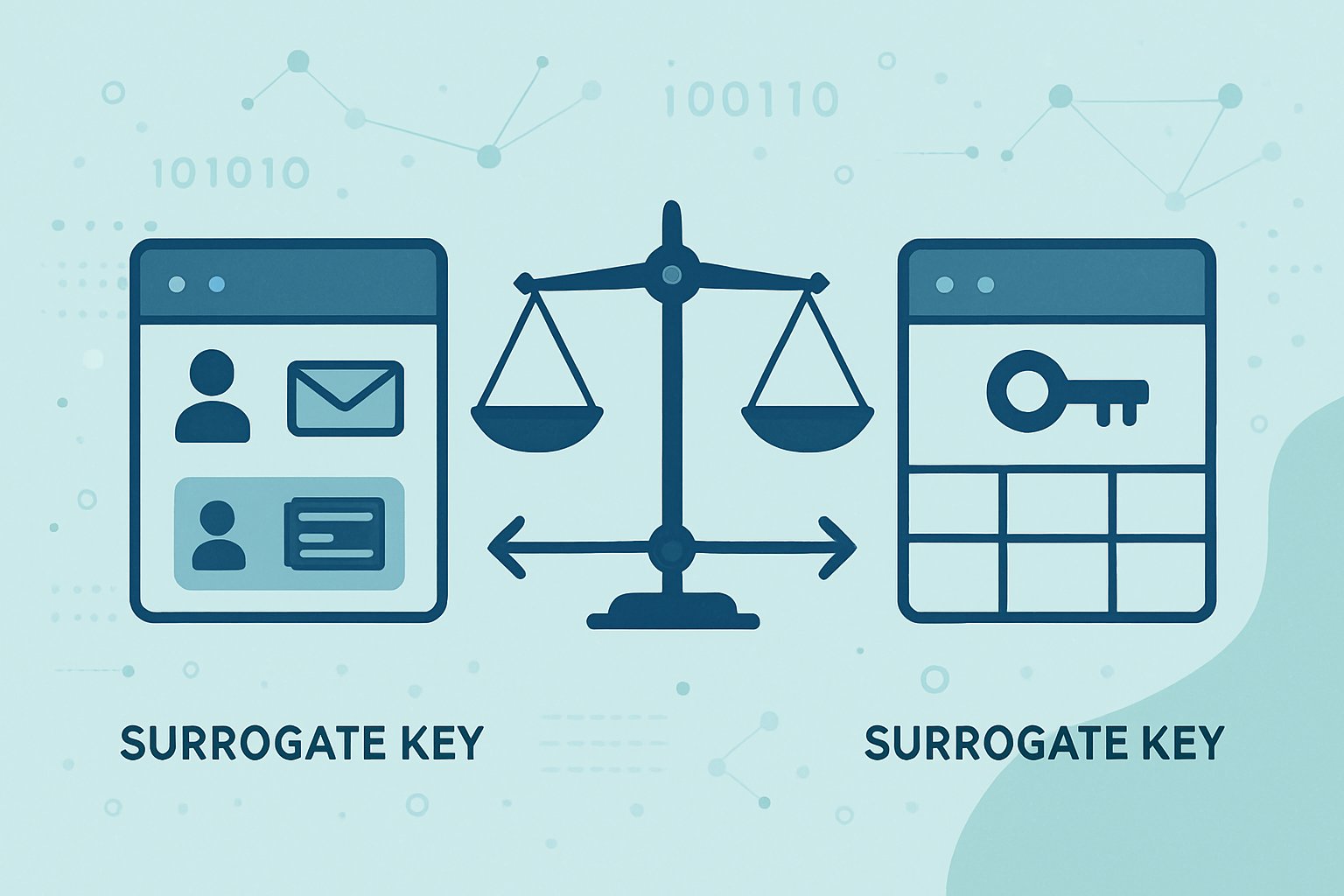
Database professionals have debated this topic for years because both approaches have clear advantages and drawbacks. Natural keys use existing business data like social security numbers or product codes, making them meaningful to users. Surrogate keys are system-generated values like auto-incrementing integers that have no business meaning but offer technical benefits.
Understanding when to use each type requires looking at factors like data stability, performance requirements, and business rules. This guide will examine the core differences between these key types, explore their performance implications, and provide practical guidance for making the right choice in your database projects.
Key Takeaways
- Surrogate keys provide better performance and stability while natural keys offer business meaning and can reduce table joins
- Performance differences become significant with larger datasets, where smaller surrogate keys typically outperform multi-column natural keys
- The best choice depends on your specific requirements, with data warehouses favoring surrogate keys and some transactional systems benefiting from natural keys
Defining Surrogate and Natural Keys
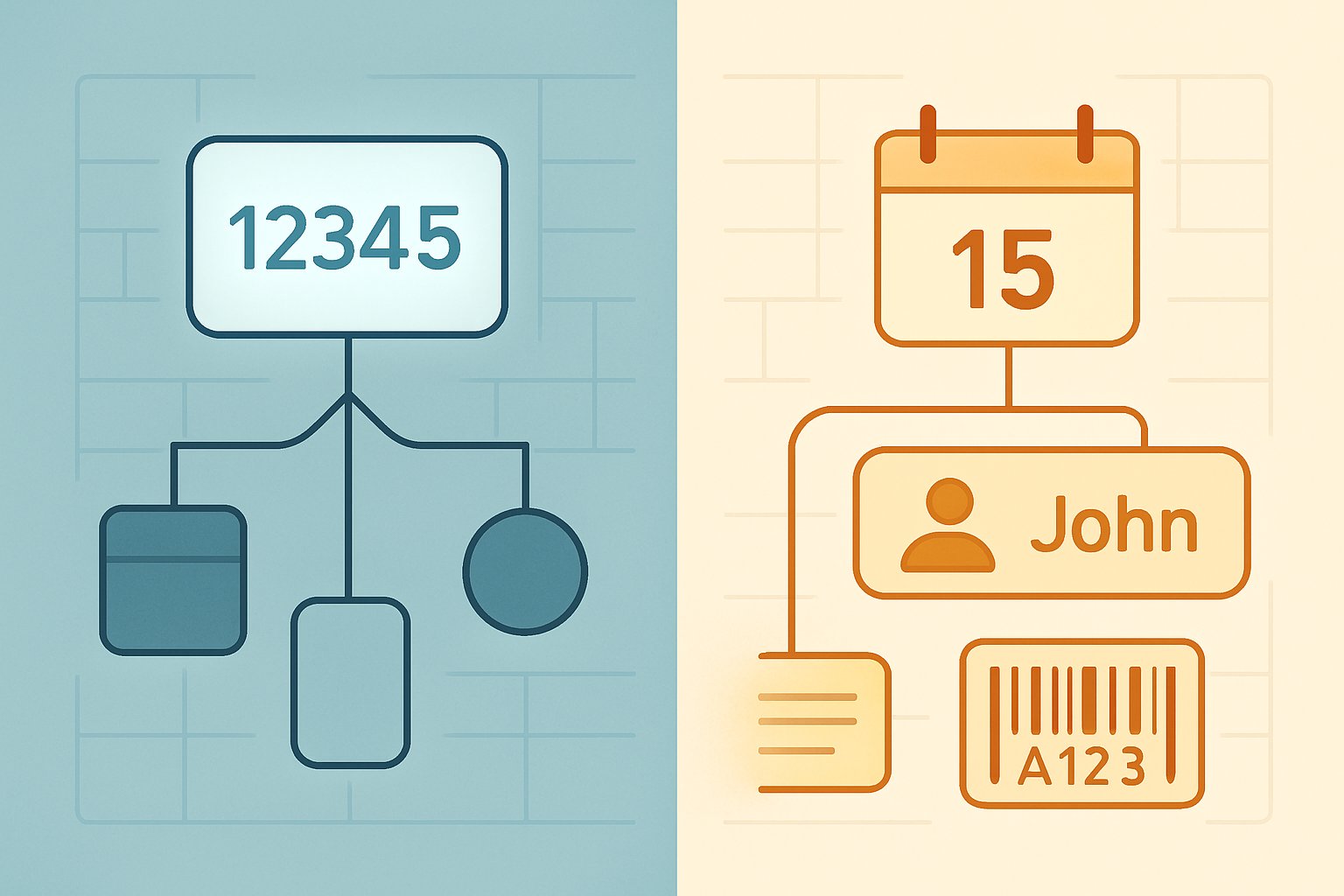
Database designers use two main types of keys to identify records uniquely: natural keys that come from real business data and surrogate keys that systems create automatically. Each type serves the same basic purpose but works in different ways.
What Is a Natural Key?
A natural key uses existing data columns that already have business meaning to identify each record uniquely. These keys come from real-world information that makes sense to users.
Social Security Numbers work as natural keys for employee tables. Email addresses can serve as natural keys for user accounts. Product codes often act as natural keys in inventory systems.
Natural keys must exist in the data before someone can create a record. The values mean something to people who work with the information every day.
Common examples of natural keys include:
- Social Security Numbers
- Email addresses
- Product serial numbers
- Account numbers
- Phone numbers
Multiple columns can work together to form a natural key. A combination of first name, last name, and birth date might create a unique identifier for a patient database.
What Is a Surrogate Key
A surrogate key is a unique identifier that database systems create automatically. These keys have no business meaning and exist only to identify records.
The system generates surrogate keys using rules that guarantee each value will be different. Users never need to know what these values mean or how they work.
Surrogate keys stay the same even when business data changes. If someone updates their email address, the surrogate key remains unchanged while a natural key might need to be modified.
Key characteristics of surrogate keys:
- System-generated values
- No business meaning
- Never change once created
- Usually single column
- Guaranteed to be unique
Database designers can add surrogate keys to any table without changing existing data or business rules.
Types of Surrogate Keys
Identity columns create sequential numbers automatically. SQL Server uses IDENTITY properties to generate values like 1, 2, 3, and so on.
GUID values produce long, random-looking strings that are almost impossible to duplicate. These work well when multiple systems need to create records at the same time.
UUID keys work similarly to GUIDs but follow specific formatting standards. They look like this: 123e4567-e89b-12d3-a456-426614174000.
Sequence objects let database designers control how numbers get created. They can start at any number and increase by any amount.
Auto-incrementing integers are the most common type of surrogate key. They use less storage space and work faster than other options.
Primary Keys and Their Role in Database Tables
Primary keys serve as the main unique identifier for each record in database tables. Every table needs exactly one primary key to work properly.
The primary key can be either a natural key or a surrogate key. This choice affects how applications access data and how tables connect to each other.
Database systems use primary keys to create special indexes that make searches faster. These indexes also prevent duplicate records from being added to tables.
Primary key requirements:
- Must be unique for every record
- Cannot contain empty values
- Should never change after creation
- Must exist for every record
Foreign keys in other tables point to primary key values to create relationships between tables. When primary keys change, all related foreign keys must also change.
Core Differences Between Surrogate and Natural Keys
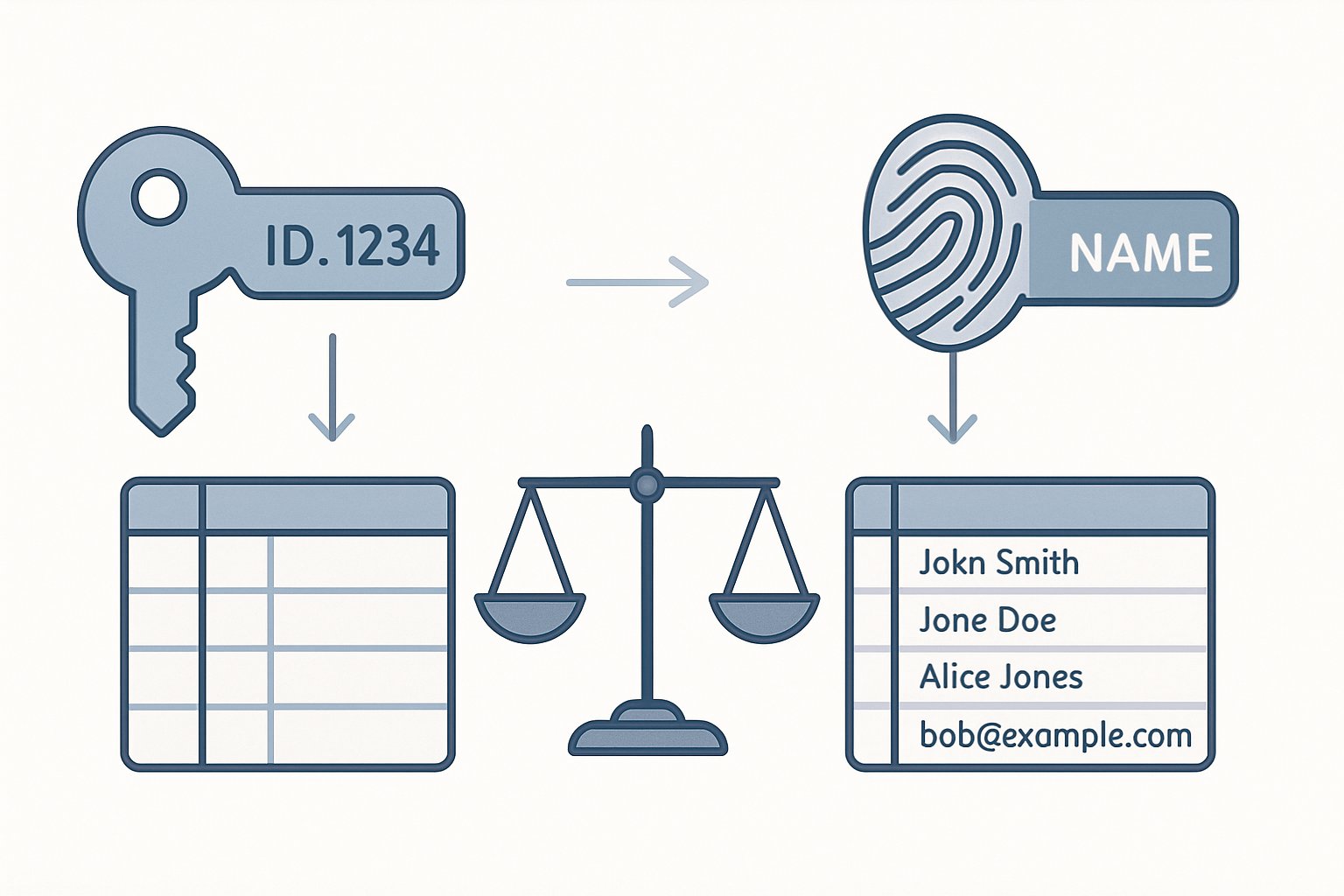
Surrogate keys and natural keys handle business logic differently, create distinct foreign key relationships, and impact database design in unique ways.
Business Logic and Data Integrity Considerations
Natural keys contain business meaning that connects directly to real-world data. A Social Security Number or product code serves as both an identifier and meaningful information. This creates immediate data integrity because the key itself validates against business rules.
Surrogate keys have no business meaning. They exist only to identify records uniquely. A sequential number like 1001, 1002, 1003 tells users nothing about the actual data.
Natural keys face challenges when business rules change. Companies expanding internationally might find that Social Security Numbers don’t work for foreign employees. The entire key structure needs updates.
Surrogate keys remain stable during business changes. Adding international employees requires only new data columns, not key changes. The surrogate key continues working regardless of business rule modifications.
Data integrity works differently for each approach. Natural keys enforce business rules through the primary key itself. Surrogate keys need separate constraints to prevent duplicate business data.
Relationship with Foreign Keys
Foreign key relationships behave differently with each key type. Natural keys create meaningful connections between tables without requiring lookup operations.
When tables use natural keys, foreign key values have business significance. An order table referencing a customer by Social Security Number provides immediate context about the relationship.
Surrogate keys require more joins to understand relationships. Foreign key values like CustomerID = 1001 mean nothing without checking the customer table. This creates additional database operations.
Natural keys can reduce query complexity in some cases. Joining tables on meaningful values eliminates the need for extra lookups to understand data relationships.
Surrogate keys standardize relationships across all tables. Every foreign key follows the same pattern, making application code more consistent and reusable.
Impact on Database Design
Database design differs significantly between key approaches. Natural keys use existing data columns as primary keys, requiring no additional storage space for key values.
Surrogate keys add extra columns to every table. Each surrogate key needs storage space and index maintenance. This increases database size and storage requirements.
Performance characteristics vary by key type. Natural keys often use larger data types or multiple columns, creating bigger indexes. Surrogate keys typically use small integers, resulting in faster index operations.
Table maintenance becomes simpler with surrogate keys. Sequential integer values create less index fragmentation during insert operations. Natural keys may cause more index reorganization.
Database normalization works differently with each approach. Natural keys align with normalization principles by using meaningful attributes. Surrogate keys technically violate strict normalization rules by adding non-business data.
Performance and Indexing Implications
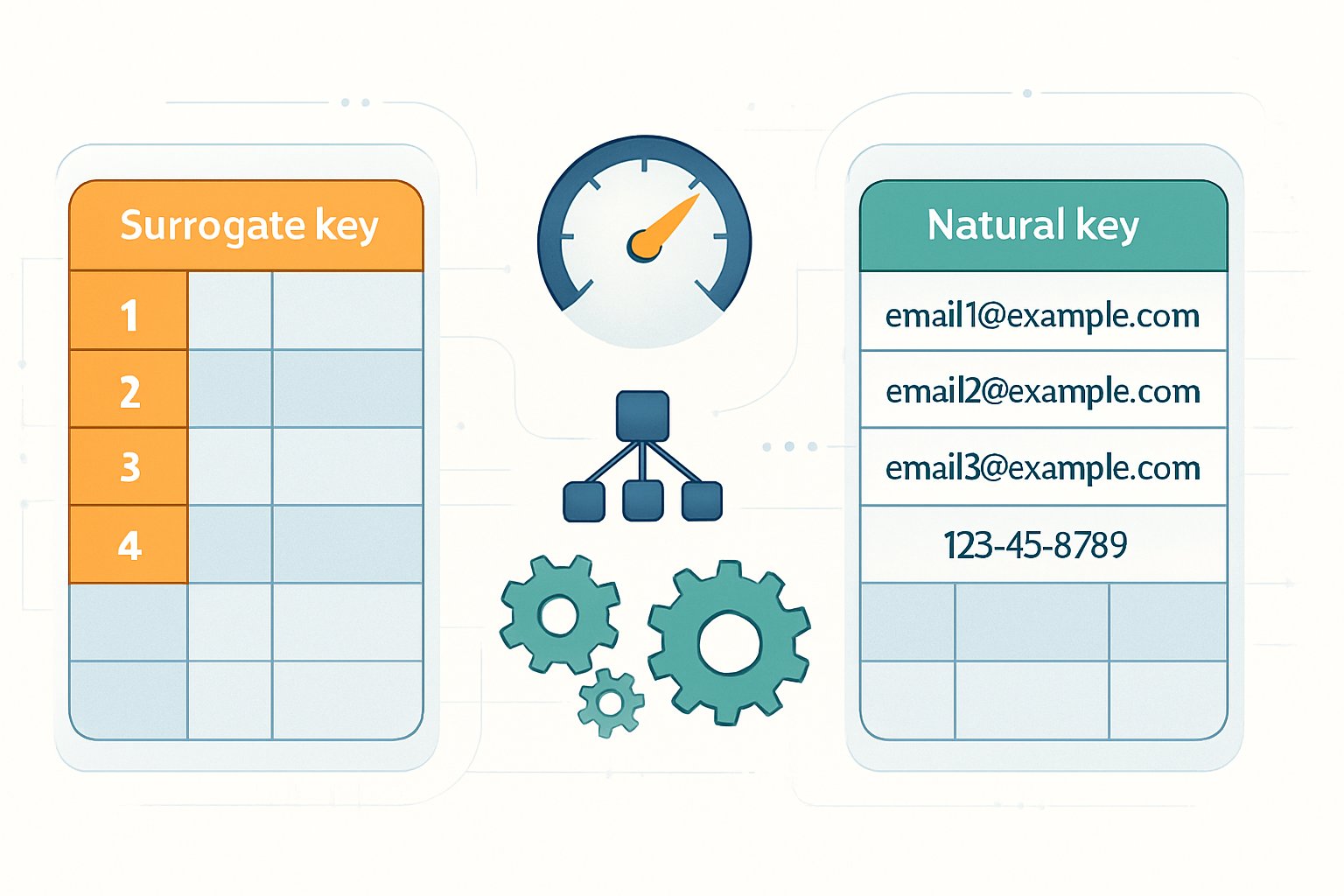
Key choice directly impacts database performance through index efficiency, query speed, and storage requirements. Surrogate keys typically offer better indexing performance due to their smaller size and sequential nature, while natural keys can reduce join operations but may consume more resources.
Indexing Efficiency and Clustered Indexes
Surrogate keys perform better in clustered indexes because they are usually small integers that create sequential values. SQL Server uses B+Trees for indexes, where seek performance relates directly to key length.
Sequential surrogate keys reduce index fragmentation. New records get added to the end of the index tree instead of causing page splits throughout the structure.
Natural keys often require more storage space in indexes. A Social Security Number uses 9 characters compared to a 4-byte integer surrogate key. This size difference multiplies across all index pages.
Clustered indexes in SQL Server add the primary key to every non-clustered index. Wider natural keys increase the size of all table indexes, not just the primary key index.
Multi-column natural keys create even larger index entries. A composite key with three columns requires significantly more disk space and memory than a single integer column.
Read and Insert Performance
Insert operations favor surrogate keys because the database generates sequential values automatically. Natural keys may require validation checks against business rules or external systems before insertion.
Surrogate keys eliminate duplicate key errors during data migration. Each new record gets a unique system-generated identifier regardless of the source data.
Query performance depends on access patterns. Natural keys allow direct searches without joining to lookup tables. A customer table with email as the natural key supports fast email-based queries.
Range queries work better with sequential surrogate keys. Date-based natural keys can also perform well for time-range searches, but random natural keys like GUIDs perform poorly for range operations.
Join performance varies by key type. Smaller surrogate keys reduce memory usage during join operations, while meaningful natural keys may eliminate some joins entirely.
Storage, Scalability, and Maintenance
Storage requirements grow faster with natural keys due to their larger size. A million-row table with 20-character natural keys uses significantly more disk space than integer surrogate keys.
Surrogate keys scale better in high-volume systems. Auto-incrementing integers handle millions of inserts efficiently without key generation overhead.
Index maintenance costs increase with key size. Larger natural keys require more CPU and I/O resources during index rebuilds and updates.
Foreign key relationships multiply storage differences. Each child table that references the primary key stores the full key value, amplifying the space difference between key types.
Partitioning strategies work better with surrogate keys. Sequential values distribute evenly across partitions, while natural keys may create uneven partition sizes.
Practical Use Cases and Examples
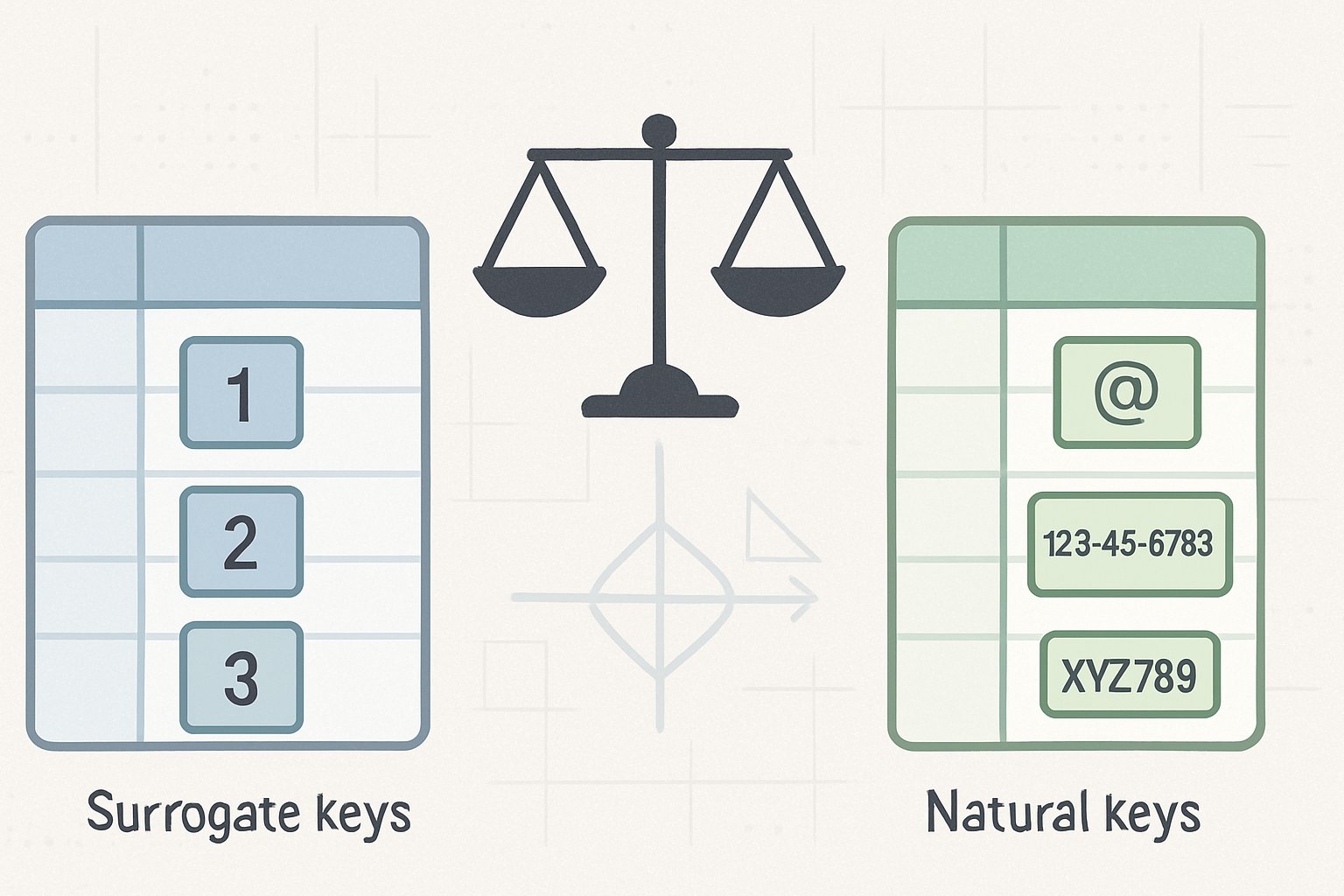
The choice between surrogate and natural keys depends on specific business needs and data characteristics. Different scenarios require different approaches based on factors like data stability, performance requirements, and business logic complexity.
When to Choose a Natural Key
Natural keys work best when the business data is stable and unlikely to change. Social Security Numbers for employee records represent a classic example where natural keys make sense in specific contexts.
Use natural keys when:
- The data has inherent business meaning that users need to search by
- The key values are guaranteed to remain constant over time
- Performance benefits from avoiding extra joins outweigh storage costs
Customer account numbers in banking systems often serve as effective natural keys. These numbers have business meaning and rarely change once assigned.
Foreign key relationships become simpler with natural keys. Child tables can reference meaningful parent values without requiring lookup operations to understand the data.
However, avoid natural keys when business requirements might force changes. Companies expanding internationally may find Social Security Numbers inadequate for global employee identification.
When to Choose a Surrogate Key
Surrogate keys excel in environments where business data changes frequently or lacks stable unique identifiers. Modern applications often benefit from surrogate keys due to their flexibility and performance characteristics.
Choose surrogate keys when:
- Business rules for identification might change over time
- Natural identifiers are composite or overly complex
- Primary key performance is critical for high-volume operations
E-commerce product catalogs benefit from surrogate keys. Product codes may change based on supplier relationships or business restructuring, but surrogate keys remain constant.
Data warehousing scenarios almost always require surrogate keys. Source systems change independently, and surrogate keys provide stability across different data integration cycles.
Foreign key relationships using surrogate keys maintain referential integrity even when source business data undergoes modifications.
Real-World Scenarios and Common Pitfalls
Healthcare systems demonstrate both approaches effectively. Patient records might use surrogate keys as primary identifiers while maintaining natural keys like medical record numbers for business operations.
Common pitfalls include choosing natural keys that later prove unstable. Government ID systems change, business rules evolve, and mergers create duplicate natural key scenarios.
Surrogate keys can create debugging challenges in production environments. Developers may struggle to identify specific records without meaningful business context during troubleshooting sessions.
Mixed approaches often work best in practice. Tables maintain surrogate primary keys for technical stability while enforcing unique constraints on natural keys for business logic validation.
Testing environments highlight another consideration. Surrogate keys make it difficult to distinguish between production and test data, potentially creating compliance issues in regulated industries.
Best Practices for Primary Key Selection
Selecting the right primary key requires careful planning around business requirements and technical constraints. Database designers must balance current needs with future growth while maintaining data integrity across all systems.
Evolving Business Needs and Database Schema
Business requirements change over time, making primary key selection critical for long-term database design success. Natural keys tied to business logic can become problematic when companies expand or regulations change.
Consider an employee table using Social Security Numbers as the primary key. If the company expands internationally, not all employees will have SSNs. This creates immediate data integrity issues.
Surrogate keys provide stability during business changes. A simple integer or GUID remains valid regardless of business rule modifications.
Database designers should evaluate these factors:
- Geographic expansion plans
- Regulatory compliance requirements
- Data source integration needs
- Legacy system compatibility
Companies with stable, well-defined business rules may successfully use natural keys. Organizations expecting growth or change benefit from surrogate key implementation.
Ensuring Long-Term Data Integrity
Data integrity depends on consistent unique identifier patterns across the SQL database. Primary keys must remain stable throughout the data lifecycle.
Surrogate keys guarantee uniqueness without relying on business data that might change. Sequential integers or GUIDs never conflict with business logic updates.
Natural keys can compromise data integrity when:
- Source data contains duplicates
- Business rules change key definitions
- Data migration introduces conflicts
- Multiple systems use different formats
Primary key constraints should include:
- NOT NULL requirements on all key columns
- UNIQUE constraints to prevent duplicates
- Proper indexing for query performance
- Foreign key relationships that cascade correctly
Test environments benefit from surrogate keys because they generate new values during data loads. This prevents primary key conflicts when moving data between systems.
Guidelines for SQL Databases
SQL database performance depends heavily on primary key design choices. Smaller keys improve query speed and reduce storage requirements.
| Key Type | Storage Size | Index Performance | Join Complexity |
|---|---|---|---|
| Integer surrogate | 4 bytes | Excellent | Simple |
| GUID surrogate | 16 bytes | Good | Simple |
| Single natural | Varies | Good | Moderate |
| Composite natural | Large | Poor | Complex |
Choose integer surrogate keys for high-transaction systems. They provide the best insert performance and smallest storage footprint.
Use natural keys only when:
- Business meaning adds query value
- Key values never change
- Single column provides uniqueness
- Performance impact is acceptable
Avoid composite natural keys in most scenarios. They create complex foreign key relationships and slow join operations.
IDENTITY columns in SQL Server or SERIAL types in PostgreSQL work well for surrogate keys. They handle concurrent inserts safely and maintain sequential order.
Frequently Asked Questions
Database developers often debate whether surrogate or natural keys work better for primary keys. Performance differences, reliability concerns, and normalization rules create common questions about these two approaches.
What are the main differences between surrogate keys and natural keys?
Surrogate keys are system-generated values with no business meaning. They use sequential integers, GUIDs, or other unique identifiers created by the database.
Natural keys come from existing data columns that have business meaning. Examples include Social Security Numbers, email addresses, or product codes.
The key difference lies in their relationship to business data. Surrogate keys exist only to identify records uniquely. Natural keys serve as both identifiers and meaningful business information.
How do surrogate keys impact the performance of a database compared to natural keys?
Surrogate keys typically offer better performance than natural keys. They use smaller data types like integers, which require less disk space and memory.
Smaller keys mean faster index operations and quicker joins between tables. Sequential surrogate keys also reduce index fragmentation since new values are always increasing.
Natural keys often use larger data types or multiple columns. This increases the amount of data that must be read and written during database operations.
In what scenarios is it advisable to use surrogate keys over natural keys?
Data warehouses require surrogate keys because source systems can change over time. Surrogate keys protect the warehouse from these external changes.
Use surrogate keys when natural key values might change due to business requirements. For example, if a company expands internationally, Social Security Numbers won’t work for all employees.
Surrogate keys work well when no good natural key exists or when multiple candidate keys create design complexity. They also help when applications need to insert placeholder records before all data is available.
Can surrogate keys be considered more reliable than natural keys for database integrity?
Surrogate keys provide more reliable database integrity because they never change once assigned. The database system controls their generation and ensures uniqueness.
Natural keys can change when business rules change or when data entry errors are corrected. These changes require updates across all related tables.
However, surrogate keys allow duplicate natural key values unless additional unique constraints are added. This can actually reduce data integrity if not handled properly.
What are the implications of using surrogate keys on database normalization?
Surrogate keys technically violate Third Normal Form because they have no relationship to the actual data. The key exists independently of business attributes.
Despite this theoretical violation, surrogate keys are widely accepted in practice. They often make database design simpler and more maintainable.
Database professionals generally accept this trade-off because the practical benefits outweigh the normalization concerns. Most modern database designs use surrogate keys without normalization issues.
How do surrogate keys interact with composite keys and foreign keys in database design?
Surrogate keys eliminate the need for composite primary keys. A single surrogate key column replaces multiple natural key columns.
This simplification makes foreign key relationships easier to manage. Child tables only need to reference one surrogate key column instead of multiple natural key columns.
Foreign key constraints become simpler to define and maintain. Application code also becomes easier to write when dealing with single-column keys instead of composite keys.




